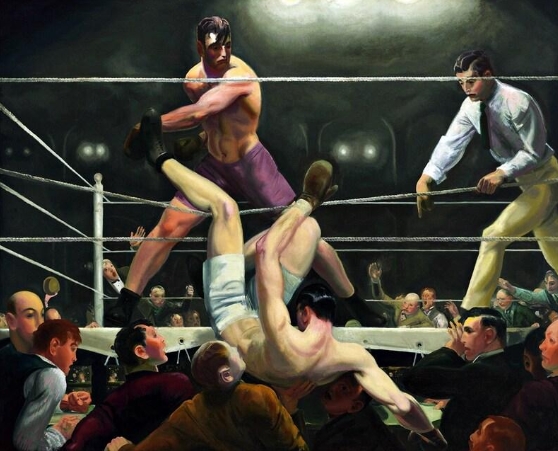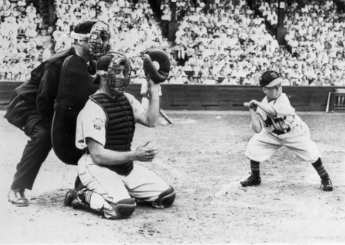Atlantic Division
Central Division
Southeast Division
Northwest Division
Pacific Division
Southwest Division
Odd Happenings in the Unpredictable World of Sports

Throughout the history of sports, there have been moments that became bizarre events, some funny, some odd, some historical. What follows are some of the most interesting, tragic, bizarre, and just downright humorous instances that took place in one sporting event or another.
We begin this trek down memory lane with a story that might be the most unbelievable of all. If you have never heard the name Frank Hayes before, you are about to learn the way his life ended in a most incredible tragic fashion. Frank Hayes participated in a sport that certainly has a limited audience. Horse Racing. Hayes trained horses and worked as a stablemate. In 1923, Hayes was 22 years old by some accounts, but others have him perishing at the age of 35. What happened to Hayes is just unthinkable. In 1923 he was asked to get in the saddle for a steeplechase at Belmont Park in New York. Hayes was on the back of the horse named “Sweet Kiss” and the odds were 20 to 1 that his horse would win the race.
This race would be Frank Hayes first and last. You see horse jockeys are small in weight with limits and Hayes needed to cut his weight from 142 pounds down to 130. He shed the weight in a single day. He did this by jogging until he got to the desired weight. He also failed to drink any water in this process and by the time he saddled up, he appeared weak and exhausted. Whether you believe it or not, a jockey riding a horse can be taxing because of the need to use arms and legs to get the horse moving to the speed necessary to win a race. It has been said a jockey can get their heart rates up to a beat of 180 times a minute. Once the race began, Hayes never got to finish. Not alive anyway. At one point in the race, he suffered a fatal heart attack, but even being dead, he remained on the horse and Sweet Kiss won the race. When officials went to congratulate hm they discovered he had died during the race. Thus, Hayes became the only horse jockey in history to die during a race and yet win the race. His horse Sweet Kiss never raced again.
For baseball fans, many might remember Jim Abbot from a few years back. A remarkably successful pitcher in Major League Baseball who was born without his right hand. Still, he was able to have a distinguished career in baseball learning how to switch his glove when fielding and how to hold his bat when at the place. Now go back to 1945 and there was another major league baseball player who unlike Abbott did not find as much success in Major League Baseball but still made it there albeit for only one season. His name was Pete Gray, and his physical limitations were a bit more extreme than Abbott. Gray was born with all his limbs intact but in 1923 while on his farm, and the accident severely damaged his right arm and it had to be amputated above the elbow.
Gray’s love for baseball endured and he had a successful minor league career after teaching himself how to field and hit despite the loss of his arm. In 1942 while playing for the Trois-Rivieres Rendards in the Canadian American League a “C” level league, Gray played in 42 games and batted .381. The St. Louis Browns in the American League signed him to a contract in 1945 and he lasted just one season, but the fact is, he made it to the majors. That year he finished with 77 games played but hit just .218. Of his 51 hits, two were triples and six were doubles.
Gray had a relatively long life passing away at the age of 87 in 2002 and his resting place is at St. Mary’s Cemetery in Hanover Township, Pennsylvania. Gray was a native of Nanticoke in Pennsylvania born March 6, 1915.A movie was made about him in 1986 called “A Winner Never Quits” and it starred Keith Carradine and Mare Winningham. There is also a biographical book titled “One Armed Wonder: Pete Gray, Wartime Baseball” as well as American Dream by William C. Kashatus.
As for bizarre moments in sports, there may not be a more outrageous moment ever than what took place in a heavyweight boxing championship between Mike Tyson and Evander Holyfield. The fight was rematch after Holyfield had won the WBA title from Tyson in late 1996 and this bout took place on June 28, 1997. The fight took place at the MGM Grand Garden Arena in Paradise, Nevada. Entering the fight Holyfield’s record stood at 33-3 with 24 knockouts and Tyson was there with 45-2 mark and 39 KOs. Both weighed in at the same amount (218) and Holyfield was defending his WBA title. He was also Ring Magazine’s 9th ranked fighter. Holyfield had also previously won the light heavyweight championship.
As the fight began, Holyfield began to dominate Tyson. During the second round some incidental head butting occurred by Holyfield. One of those headbutts caused a cut on Tyson and in the third round, after taking a heavy shot Tyson found himself in a clinch by the defending champion and in the clinch, Tyson leaned in and bit Holyfield on his right ear. Agonizing in pain, referee Mills Lane stopped the fight Marc Ratner, the chairman of Nevada’s athletic commission ordered Tyson to be disqualified but Lane allowed it to continue.
A few moments later Tyson did it again, but this time bit the other ear, tearing away some of Holyfield’s left ear. At that point Tyson was officially disqualified and went into a rage indicating he bit Holyfield in retaliation for the head butt. Tyson, in biting Holyfield’s ear, spit the piece of skin to the canvas. Interestingly enough, these two men are friends to this day.
VIDEO: Mike Tyson Bites Holyfield's Ear Clean Off'
When you think of funny moments in sports, perhaps one of the most humorous videos you will ever see is when Mark Sanchez had his now infamous “Butt Fumble.” But when it comes to embarrassment, two plays took place on both the collegiate and professional level that mirror each other. It is rare that a football player picks up a fumble and tries to score but ends up running in the wrong direction. Well, that has happened twice where it became a major story, one on the amateur level and the other in the NFL.
In college, the year was 1929 and the annual Rose Bowl was being played between the University of California (Berkeley) and Georgia Tech. The date was New Year’s Day, and one Roy Riegels playing for California was on defense in the position of what is now known as a nose tackle. Riegels also played center on offense. But facing the Yellow Jacket’s offense, Tech’s Jack “Stumpy” Thomas on his own 30-yard line when he fumbled the ball. Riegels picked up the loose ball and began to run towards what he thought was the Yellow Jackets’ end zone but instead was heading for his own end zone. Riegels ran 69 yards in what would have been a safety had he reached the end zone, but his teammate Benny Lom caught up to him all the way screaming at him to stop. Obviously Riegels did not hear him.
Lom and his teammates tackled their own man at the three-yard line as they also tried to turn him around. But Riegels went down to the turf. Lom would end up punting the ball as decided by his coach because California did not want to risk running plays so deep in their own territory. However. Lom’s punt was blocked, and Georgia Tech turned it into a safety giving their team a 2-0 lead. Forever more, Riegels became known as “Wrong Way Roy.” In his own words he explained the play:
“I was running toward the sidelines when I picked up the ball. I started to turn to my left toward Tech’s goal. Somebody shoved me and I bounded right off into a tackler. I’m pivoting to get away from him, I completely lost my bearings.”
VIDEO: Roy Riegels' Wrong Way Run in the Rose Bowl
Move ahead 35 years to the National Football League and the Minnesota Vikings were playing the San Francisco 439ers on October 25, 1964. On defense for the Vikings was the great Jim Marshall. Just like the Rose Bowl game 35 years earlier Marshall like Riegels picked up a fumble and began to run the wrong way. The difference this time is that Marshall made it to his own end zone which of course became a safety. Marshall threw the ball up thinking he had just scored a defensive touchdown. He redeemed himself later in the game when he forced a fumble which his teammate Carl Eller returned for a score which turned out to be the deciding factor in Minnesota’s 27-22 victory. Months later, Marshall was sent a letter from none other than Roy Riegels who said in the later, “Welcome to the club.”
VIDEO: Touchdown Fail. Guy Runs the Wrong Way
Back to boxing and in one of the most famous sports paintings in history is a representation of the boxing heavyweight title fight between Luis Firpo and defending champion Jack Dempsey. Dempsey is one of the greatest champions of all time and is knowns as “The Manassa Mauler.”
Firpo, the challenger had the nickname “El Toro Salvaje de las Pampas (The Wild Bull of Pampas) hailing from Junin, Buenos Aires. At the time of the fight Dempsey’s record was 61-4-9 and Firip 25-2. The fight took place on September 14, 1924, takin place at the old Polo Grounds in New York City. In the first round alone, Firpo was obviously in over his head suffering knockdowns seven times. But Firpo kept getting up and was able to get Dempsey up against the ropes throwing combinations that knocked Dempsey out of the ring. With a 10-count going on, the champion with assistant from others made it back into the squared circle. Strangely enough the referees count did not start right away, and Dempsey was outside the ropes for 17 seconds. Firpo continued his onslaught when the fight continued landing 13 straight punches. The round ended and Dempsey had decided enough was enough and knocked Firpo out in the second round was the fright went down as the Ring Magazine Fight of the Year for 1923.

While we began this article with the death of a jockey, in Major League Baseball throughout its long history there has been just one single incident of a player dying on the field of play. That unfortunate soul was Ray Chapman. The date was August 16, 1920, and Chapman was playing for the Cleveland Indians. He made his debut with the team almost to the day this incident took place on August 20, 1912. On that day in 1920 the Indians were facing the New York Yankees and Carl Mays was on the mound for the pinstripes.
Carl Mays had a submarine type of motion to his pitches and when he faced Chapman, the game was in its latter stages and in this era, tampering with baseballs was common. This type of activity often made the ball less visible and using his sidearm delivery Mays threw a pitch that came inside, and Chapman just stood at the plate as the ball crashed into his skull. Witnesses say the sound of him being hit was so loud that even Mays thought the ball had hit his bat and in fact the ball rolled back to Mays who fielded it and made a throw to first base.
Laying at home plate, Ray Chapman was bleeding from his left ear and the home plate umpire Tommy Connolly yelled for a doctor. The great Tris Speaker was in the on-deck circle and rushed to Chapman’s side. The batter did manage to get to his feet and tried to walk but his knees buckled, and he fell back down. He did manage to speak and said “I’m all right. Tell Mays not to worry. Ring …Katie’s ring.” Katie was his wife who was also pregnant at the time. He then fell again unconscious. After arriving at St. Lawrence Hospital, he died at 4:40 am because of brain damage. His wife Katie fainted upon hearing the news. Because of his death, his teammates wore black armbands the remainder of the season. Ironically, the Indians won the World Series that year.
The final two stories come from Major League Baseball. Bill Veeck who was once a very colorful and innovate owner of the Chicago White Sox and St. Louis Browns would often pull pranks in the game to make it more interesting. One event stands out much more than anything he did before. On August 19, 1951, Veeck obviously thought it would be funny to sign a dwarf to his roster and put him up to bat in a live game. In came Eddie Gaedel, all 3 feet 7 inches tall and weighing just 90 pounds. On the mound for the Detroit Tigers was Bob Cain and his battery mate was Bob Swift who had to go to his knees to catch the incoming pitches given Gaedel’s height. Cain could be seen laughing hysterically probably because getting a ball inside the small batter’s strike zone would be impossible.
Wearing jersey number 1/8, Gaedel was instructed to just stand there and take pitches. Naturally, he walked on four straight balls and trotted down to first base where he was replaced by a pinch runner. That was the end of his career in baseball and tragically, Gaedel died on June 18, 1961, at the age of 36 after being mugged and beaten and then suffering a heart attack. Strangely enough, his death came 10 days and 10 years to the date of his MLB debut.

Finally, we have an absolute oddity that will probably never happen again. The “Big Unit” Randy Johnson was on the staff of the Arizona Cardinals on March 24, 2001 when in spring training his team was playing the San Francisco Giants and In the seventh inning as Johnson was getting ready to throw another pitch, and his best pitch was the fastball which often traveled to home plate better than 100 miles-per-hour. Unfortunately, on this one pitch a morning dove crossed in front of the ball and was in direct line of the pitch as the ball hit the bird full force killing him instantly.
The Giants’ Jeff Kent picked up the dead bird and gave a big smile. Johnson who threw the pitch did not find any humor in it. Said Johnson, “I didn't think it was all that funny, it was "a blur."
VIDEO: Randy Johnson Hits Bird with Pitch
So, there you have it, some moments in sports that most likely never happen again. But they are true and in the books as history.





